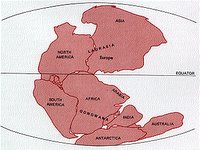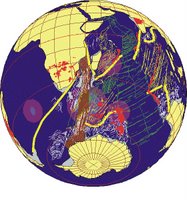I know I keep writing about it, when discussing the origins of Australian plants, most recently with discussion of the Eucryphia trees of Robertson. And before that, when discussing the Proteaceous plants (Waratahs, Banksias, Hakeas and Persoonias, Grevilleas, etc.)
 Well, the “boffins” tell me that before Gondwana was “Pangea”, a supercontinent which included Laurasia (basically the northern continents we know today) and Gondwana (basically the southern continents, plus India). This drawing comes from John W Kimball’s website called “Biology”.
Well, the “boffins” tell me that before Gondwana was “Pangea”, a supercontinent which included Laurasia (basically the northern continents we know today) and Gondwana (basically the southern continents, plus India). This drawing comes from John W Kimball’s website called “Biology”. So too is the yo-yo movement of Australia, first north, then south again, before heading relentlessly north again until it reaches its present position.
So too is the yo-yo movement of Australia, first north, then south again, before heading relentlessly north again until it reaches its present position.I invite you to go to this site and have a look. http://kartoweb.itc.nl/gondwana/gondwana_small.html
It requires the Macromedia “Shockwave Plug-in”, but this is available, free, from this site.
The part of this theoretical reconstruction which puzzles me most is that South America and Australia do not ever appear to have been close together, which makes their common heritage of plants, in the Proteaceae family, and also the Eucryphia genus more puzzling than I had first imagined. (They were, at some stage linked by that part of Gondwana which is now Antarctica.) None-the-less, I am not yet satisfied with my understanding of these early continental relationships.
I suspect that this is possibly a distortion introduced because of the somewhat arbitrary orientation of the “map” on which these maps are based. I would like to see a “globe” reconstruction, rather than a flat map, to see if these distortions disappear.

No comments:
Post a Comment